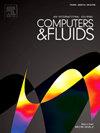Deep learning-based reduced order model for three-dimensional unsteady flow using mesh transformation and stitching
IF 3
3区 工程技术
Q3 COMPUTER SCIENCE, INTERDISCIPLINARY APPLICATIONS
引用次数: 0
Abstract
Artificial intelligence-based three-dimensional fluid modeling has gained significant attention recently. However, the accuracy of such models is often limited by the preprocessing of irregular flow data. In order to bolster the credibility of near-wall flow prediction, we present a deep learning-based reduced order model for three-dimensional unsteady flow using the transformation and stitching techniques for multi-block structured meshes. To begin with, full-order flow data is provided by numerical simulations that rely on multi-block structured meshes. The mesh transformation technique is applied to convert each structured grid with data into a corresponding uniform and orthogonal grid, which is subsequently stitched and filled. The resulting snapshots in the transformed domain contain accurate flow information for multiple meshes and can be directly fed into a structured neural network without requiring any interpolation operation. Subsequently, a network model based on a fully convolutional neural network is constructed to predict flow dynamics accurately. To validate the strategy's feasibility, the flow around a sphere with Re=300 was investigated, and the results obtained using traditional Cartesian interpolation were used as the baseline for comparison. All the results demonstrate the preservation and accurate prediction of flow details near the wall, with the pressure correlation coefficient on the wall achieving a remarkable value of 0.9997. The stitching scheme that follows the proposed standard can effectively reduce the accumulation of inferring errors. Moreover, the periodic behavior of flow fields can be faithfully predicted during long-term inference. This work demonstrates that the proposed strategy has the advantage of high efficiency while providing accuracy assurance for downstream tasks.
利用网格变换和拼接技术,建立基于深度学习的三维非稳定流降阶模型
基于人工智能的三维流体建模近来备受关注。然而,此类模型的准确性往往受到不规则流动数据预处理的限制。为了提高近壁流动预测的可信度,我们利用多块结构网格的变换和拼接技术,提出了一种基于深度学习的三维非稳态流动降阶模型。首先,全阶流动数据由依赖于多块结构网格的数值模拟提供。网格转换技术可将每个结构网格数据转换为相应的均匀正交网格,然后进行拼接和填充。转换后域中的快照包含多个网格的精确流动信息,可直接输入结构化神经网络,无需任何插值操作。随后,构建一个基于全卷积神经网络的网络模型,以准确预测流动动态。为了验证该策略的可行性,我们研究了 Re=300 的球体周围的流动情况,并将使用传统笛卡尔插值法获得的结果作为比较基准。所有结果都证明了对壁面附近流动细节的保留和准确预测,壁面上的压力相关系数达到了惊人的 0.9997。采用所提出标准的拼接方案可以有效减少推断误差的积累。此外,在长期推断过程中,流场的周期性行为也能得到忠实预测。这项工作表明,所提出的策略具有高效率的优势,同时还能为下游任务提供精度保证。
本文章由计算机程序翻译,如有差异,请以英文原文为准。
求助全文
约1分钟内获得全文
求助全文
来源期刊

Computers & Fluids
物理-计算机:跨学科应用
CiteScore
5.30
自引率
7.10%
发文量
242
审稿时长
10.8 months
期刊介绍:
Computers & Fluids is multidisciplinary. The term ''fluid'' is interpreted in the broadest sense. Hydro- and aerodynamics, high-speed and physical gas dynamics, turbulence and flow stability, multiphase flow, rheology, tribology and fluid-structure interaction are all of interest, provided that computer technique plays a significant role in the associated studies or design methodology.
 求助内容:
求助内容: 应助结果提醒方式:
应助结果提醒方式:


